by Lisa Cooke | Nov 21, 2015 | 01 What's New, Photographs, Social Media, Writing Family History
Here’s an innovative way to use Facebook for family history. It comes from my downloadable video class, Pain-Free Family History Writing Projects.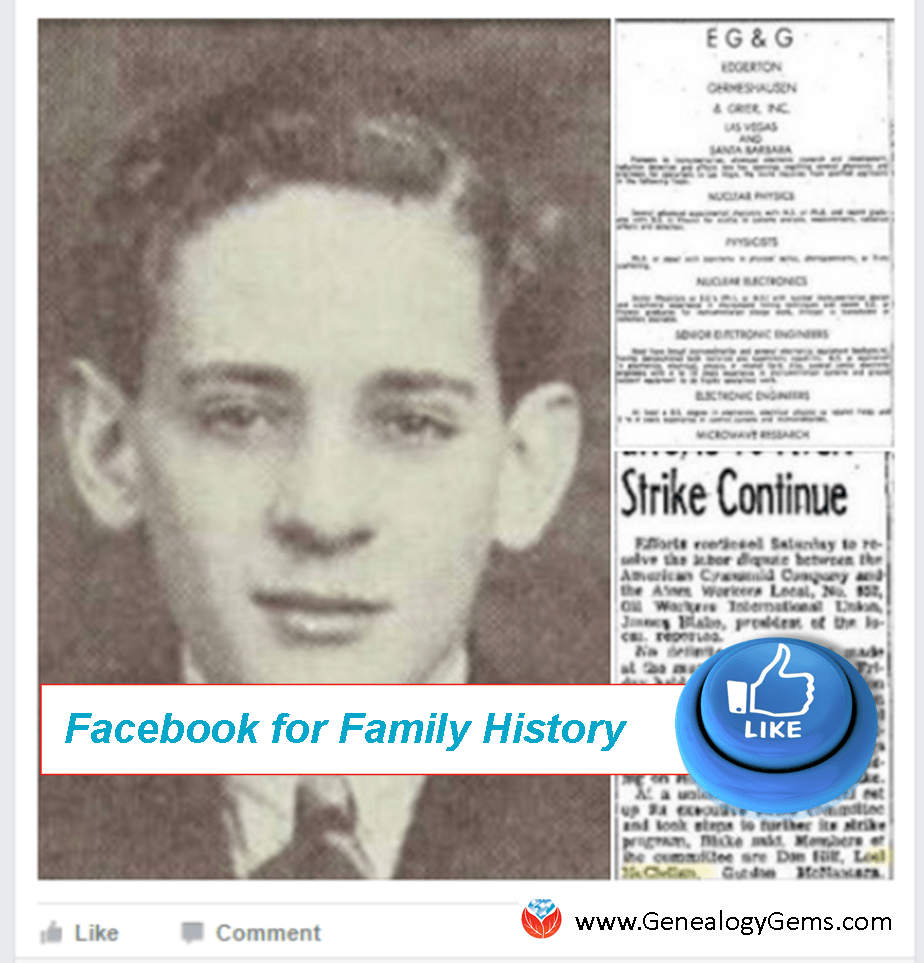
Are you using Facebook to gather family history from your relatives? You can! It’s a version of “crowd-sourcing,” or using the internet to ask lots of people at a time for help. Here are two specific examples:
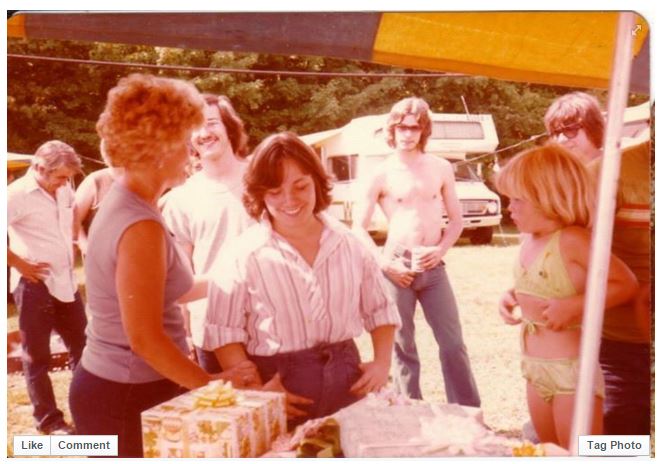 I posted this first photo in my husband’s family reunion Facebook page, after being given a ton of photos from past reunions. I couldn’t identify anyone in the picture and I couldn’t tell what was happening, but it looked like something special. After I posted it, one person commented, “Boy that’s an old photo of me”–which identified someone in the picture! Then an aunt commented that this was a bridal shower held during the annual family reunion. Yay! The mystery photo was captioned.
I posted this first photo in my husband’s family reunion Facebook page, after being given a ton of photos from past reunions. I couldn’t identify anyone in the picture and I couldn’t tell what was happening, but it looked like something special. After I posted it, one person commented, “Boy that’s an old photo of me”–which identified someone in the picture! Then an aunt commented that this was a bridal shower held during the annual family reunion. Yay! The mystery photo was captioned.
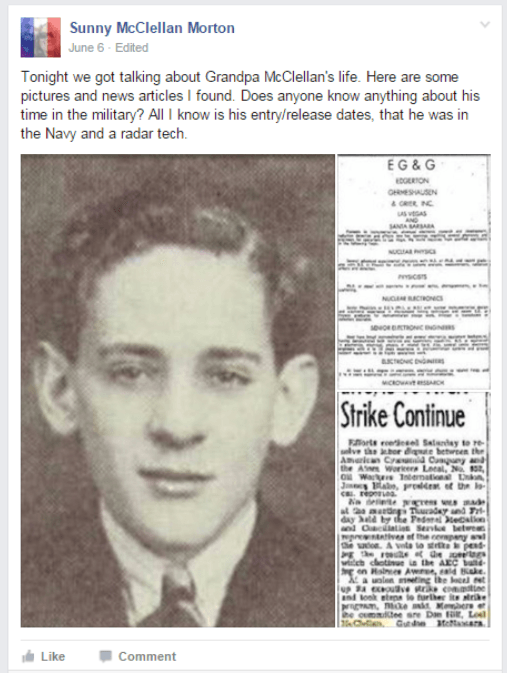 In this second example, I asked for more than just a photo caption. I posted a yearbook photo of my grandfather and two newspaper articles about him in our family Facebook group. In the accompanying post I asked, “Does anyone know anything about his time in the military? All I know is his entry/release dates, that he was in the Navy and a radar tech.” I tagged several close relatives so they would see it. (This was in our closed Facebook group. You can tag people by typing the @ sign and then their names in the post or in a comment below it.)
In this second example, I asked for more than just a photo caption. I posted a yearbook photo of my grandfather and two newspaper articles about him in our family Facebook group. In the accompanying post I asked, “Does anyone know anything about his time in the military? All I know is his entry/release dates, that he was in the Navy and a radar tech.” I tagged several close relatives so they would see it. (This was in our closed Facebook group. You can tag people by typing the @ sign and then their names in the post or in a comment below it.)
The response was fantastic. My aunt said grandpa served on a ship in the Atlantic and mentioned a rank she thinks he achieved. My uncle said he had some related papers and would send them to me (yay!). Even better, some younger family members commented how much a sibling or son looked like grandpa at that age. A cousin snagged what I’d posted for her daughter’s family history project. So even those younger relatives who couldn’t tell me about grandpa could benefit from the online conversation.
BONUS TIP: I get the best response when I post an image or video along with my questions. Pictures and videos will catch people’s interest, jog their memories and sometimes prompt additional comments. This is a good way to remind people of your interest in the family stories and to share what you already have.
This story collecting tip came from my video class: Pain-Free Family History Writing Projects.
by Lisa Cooke | Nov 20, 2015 | 01 What's New, Ancestry, Cloud Backup, Disaster Prevention, Trees
THIS IS IT! Our #1 blog post of 2015. Not surprisingly, it’s about how to secure your data on Ancestry.com: your trees, photos, sources and even DNA! 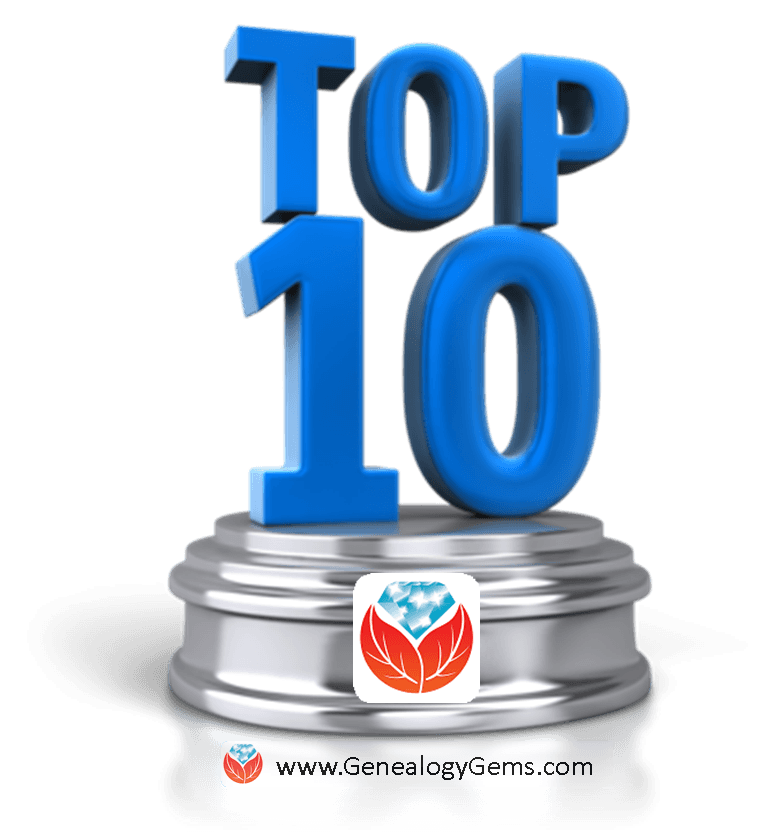
Earlier this year, rumors circulated that Ancestry was up for sale. Our post about that rumor included tips about how to back up everything you’ve put on Ancestry–trees, source citations, images and even DNA results. That post from our genealogy blog circulated among thousands and thousands of Facebook friends! It was definitely our most-read post of 2015, thanks to those of you who helped share its tips with your friends.
Here’s the bottom line from that post: if you don’t already have up-to-date copies of everything you’ve 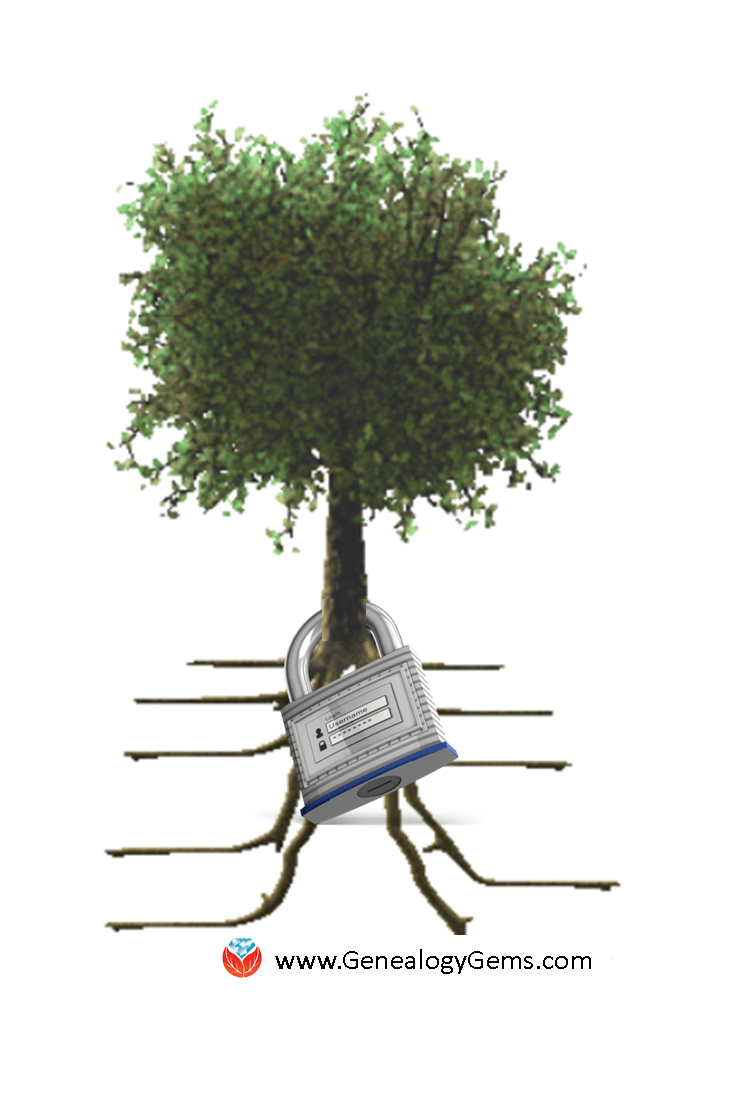 put on Ancestry, download it now. From here on out, keep your master family tree not on Ancestry (or any other site) but on your own computer. If you do keep building your tree on Ancestry, download updated GEDCOM files regularly. That way, if Ancestry gets hacked, goes out of business or even dumps your data (it’s happened before), you’ve still got your tree.
put on Ancestry, download it now. From here on out, keep your master family tree not on Ancestry (or any other site) but on your own computer. If you do keep building your tree on Ancestry, download updated GEDCOM files regularly. That way, if Ancestry gets hacked, goes out of business or even dumps your data (it’s happened before), you’ve still got your tree.
In that same spirit, back up 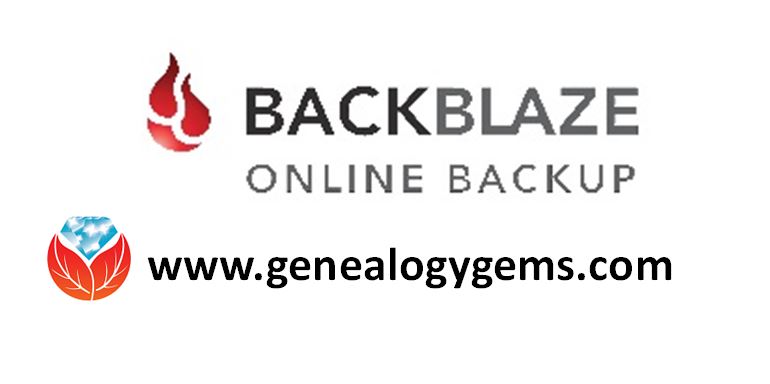 your own computer systems. Many of you have taken our advice to hire Backblaze to do this for you. Backblaze runs in the background of all Genealogy Gems computers, instantly backing up to the cloud every new or revised file we create, 24/7. Including our master family trees, digital photos and genealogy document images! Lisa loves that their online backup security is second to none and costs just $5 a month. (Click here to learn more about Backblaze.)
your own computer systems. Many of you have taken our advice to hire Backblaze to do this for you. Backblaze runs in the background of all Genealogy Gems computers, instantly backing up to the cloud every new or revised file we create, 24/7. Including our master family trees, digital photos and genealogy document images! Lisa loves that their online backup security is second to none and costs just $5 a month. (Click here to learn more about Backblaze.)
 Click here to see all Top 10 Genealogy Gems blog posts for 2015–and enter to win a great prize! The contest ends TODAY, so click now to enter!
Click here to see all Top 10 Genealogy Gems blog posts for 2015–and enter to win a great prize! The contest ends TODAY, so click now to enter!
by Lisa Cooke | Nov 19, 2015 | 01 What's New, Blogs, Google Earth
 Lisa Louise Cooke’s free Google Earth for Genealogy online video is so popular, the announcement about it was our #4 genealogy blog post for the year! Guess what? The online video is still there–and it’s still free.
Lisa Louise Cooke’s free Google Earth for Genealogy online video is so popular, the announcement about it was our #4 genealogy blog post for the year! Guess what? The online video is still there–and it’s still free.
Google Earth is one of Google’s most powerful tools for helping us understanding our ancestor’s world. (And if you read our #6 top post about other Google technologies you can use for genealogy, you know that’s saying something!)
With Google Earth, we can use satellite imagery, terrain maps, 3-D views of city streets and even overlays of old maps to learn about an ancestor’s town, neighborhood and even the very property they lived on. Even better, as Lisa demonstrates in her free video, we can also use Google Earth to share those discoveries with others in multimedia style.
Click here to “fly” (as Google Earth would say) to Lisa’s FREE Google Earth for Genealogy class!
We hope you are enjoying this week’s celebration of our Top 10 blog posts. Don’t forget about our countdown prize this week! Click here to see all Top 10 posts on our genealogy blog–and share that post on your Facebook page by THIS Friday (November 20, 2015). Use the hashtag #genealogygems, and you’ll be entered in a contest to win my Pain Free Family History Writing Project video course download, donated by our friends at Family Tree University. Add any comments you’d like on your “shared” post, like which Genealogy Gems blog post has most inspired you or helped your research. That feedback helps us bring you more posts you’ll love.
 Ready, set, SHARE! And thank YOU for helping us celebrate our 1000th blog post here at Genealogy Gems.
Ready, set, SHARE! And thank YOU for helping us celebrate our 1000th blog post here at Genealogy Gems.
by Lisa Cooke | Nov 18, 2015 | 01 What's New, Ancestry, DNA
 “This is huge!” That’s how DNA expert Diahan Southard summed up major advances at AncestryDNA this past year. Her post was huge, too: it landed the #5 spot on our Top 10 genealogy blog posts for 2015 countdown. See why!
“This is huge!” That’s how DNA expert Diahan Southard summed up major advances at AncestryDNA this past year. Her post was huge, too: it landed the #5 spot on our Top 10 genealogy blog posts for 2015 countdown. See why!
To those who have spent a lot of time doing genetic genealogy, bringing up the launch of significant updates to AncestryDNA earlier this year may seem like old news. But it’s not. AncestryDNA is still the only company with fairly advanced tools for integrating your genetic matches with your family tree. That combo is so attractive, they’ve already acquired more than a million samples in their current DNA database–a huge pond in which to fish for genetic matches.
That’s why Diahan’s popular post on updates to AncestryDNA and DNA Circles is still newsworthy. As she explained, “This is really the first time a DNA testing company has so fully integrated genetics and genealogy. We can now find cousins in the database who do not share our particular genetics, but who do share some of the genetics of our common ancestor.”
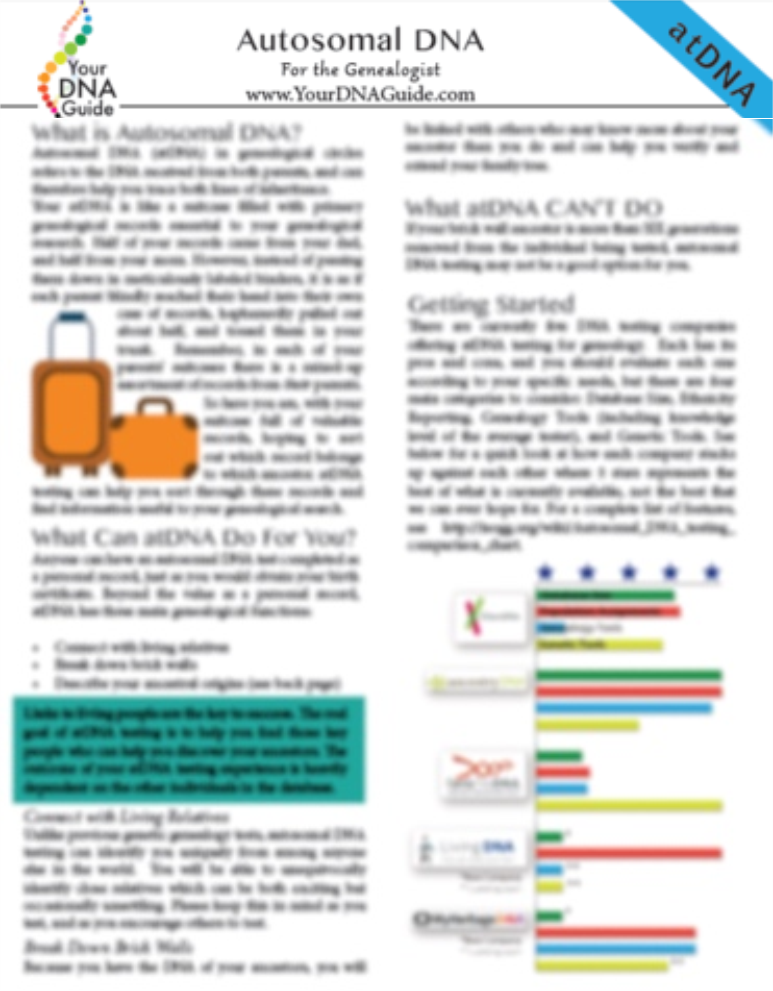 Before doing any DNA test, we always encourage genealogists to do their homework. Different tests should be used for different genealogical questions. Each company offers unique tools, perks and sometimes drawbacks for genealogy customers. Unexpected results and unpredictable encounters with genetic relatives may be difficult for some. Diahan’s Autosomal DNA for the Genealogist quick guide can help you find your way. Her other guides include those specific to AncestryDNA and autosomal DNA (the type of DNA they test at Ancestry). Click here to check them out–and see a great value price to bundle her guides.
Before doing any DNA test, we always encourage genealogists to do their homework. Different tests should be used for different genealogical questions. Each company offers unique tools, perks and sometimes drawbacks for genealogy customers. Unexpected results and unpredictable encounters with genetic relatives may be difficult for some. Diahan’s Autosomal DNA for the Genealogist quick guide can help you find your way. Her other guides include those specific to AncestryDNA and autosomal DNA (the type of DNA they test at Ancestry). Click here to check them out–and see a great value price to bundle her guides.
Once you’re ready to try an AncestryDNA test, click here to purchase, and you’ll support the free Genealogy Gem blog and podcast. (Thank you!)
Disclosure: This article contains affiliate links and Genealogy Gems will be compensated if you make a purchase after clicking on these links (at no additional cost to you). Thank you for supporting Genealogy Gems!
by Lisa Cooke | Nov 17, 2015 | 01 What's New, Ancestry, Research Skills
The Social Security Applications and Claims Index was one of 2015’s most important new online resources for U.S. researchers (keep reading to see the other). No  wonder it made the #7 spot on this week’s Top 10 genealogy blog post countdown!
wonder it made the #7 spot on this week’s Top 10 genealogy blog post countdown!
This summer, Ancestry.com quietly released a major addition to its U.S. record resources. We already rely on the Social Security Death Index to help us find 20th-century relatives. But so many of us have lamented at how limited is the info in that index, and how expensive to order the original application when there’s no guarantee we’ll find the person’s parents names (which are requested on the form).
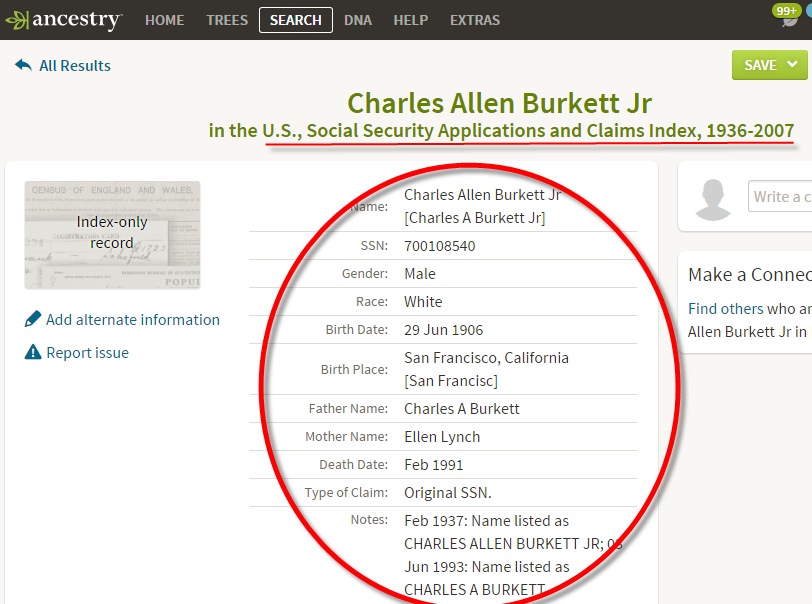 I’m guessing that’s why Lisa’s post on Ancestry’s new Social Security Applications and Claims Index made the #7 spot on our genealogy blog countdown this week! This enriched index adds parents’ names and more to millions of SSDI indexed entries. Click here to read more about it and search the index.
I’m guessing that’s why Lisa’s post on Ancestry’s new Social Security Applications and Claims Index made the #7 spot on our genealogy blog countdown this week! This enriched index adds parents’ names and more to millions of SSDI indexed entries. Click here to read more about it and search the index.
Want to read about another top database for U.S. researchers that was recently released? Click here!
Don’t forget about our countdown prize this week! Click here to see all Top 10 blog posts–and share that post on your Facebook page by THIS Friday (November 20, 2015). Use the hashtag #genealogygems, and you’ll be entered in a contest to win my Pain Free Family History Writing Project video course download, kindly donated by our friends at Family Tree University. You’re welcome to add any comments on your “shared” post, like which Genealogy Gems blog post has most inspired you or helped your research. That feedback helps us bring you more posts you’ll love.
 Ready, set, SHARE! And thank YOU for helping us celebrate our 1000th blog post here at Genealogy Gems.
Ready, set, SHARE! And thank YOU for helping us celebrate our 1000th blog post here at Genealogy Gems.

 I posted this first photo in my husband’s family reunion Facebook page, after being given a ton of photos from past reunions. I couldn’t identify anyone in the picture and I couldn’t tell what was happening, but it looked like something special. After I posted it, one person commented, “Boy that’s an old photo of me”–which identified someone in the picture! Then an aunt commented that this was a bridal shower held during the annual family reunion. Yay! The mystery photo was captioned.
I posted this first photo in my husband’s family reunion Facebook page, after being given a ton of photos from past reunions. I couldn’t identify anyone in the picture and I couldn’t tell what was happening, but it looked like something special. After I posted it, one person commented, “Boy that’s an old photo of me”–which identified someone in the picture! Then an aunt commented that this was a bridal shower held during the annual family reunion. Yay! The mystery photo was captioned. In this second example, I asked for more than just a photo caption. I posted a yearbook photo of my grandfather and two newspaper articles about him in our family Facebook group. In the accompanying post I asked, “Does anyone know anything about his time in the military? All I know is his entry/release dates, that he was in the Navy and a radar tech.” I tagged several close relatives so they would see it. (This was in our closed Facebook group. You can tag people by typing the @ sign and then their names in the post or in a comment below it.)
In this second example, I asked for more than just a photo caption. I posted a yearbook photo of my grandfather and two newspaper articles about him in our family Facebook group. In the accompanying post I asked, “Does anyone know anything about his time in the military? All I know is his entry/release dates, that he was in the Navy and a radar tech.” I tagged several close relatives so they would see it. (This was in our closed Facebook group. You can tag people by typing the @ sign and then their names in the post or in a comment below it.)

 put on Ancestry, download it now. From here on out, keep your master family tree not on Ancestry (or any other site) but on your own computer. If you do keep building your tree on Ancestry, download updated GEDCOM files regularly. That way, if Ancestry gets hacked, goes out of business or even dumps your data (
put on Ancestry, download it now. From here on out, keep your master family tree not on Ancestry (or any other site) but on your own computer. If you do keep building your tree on Ancestry, download updated GEDCOM files regularly. That way, if Ancestry gets hacked, goes out of business or even dumps your data ( your own computer systems. Many of you have taken our advice to hire
your own computer systems. Many of you have taken our advice to hire 

 Before doing any DNA test, we always encourage genealogists to do their homework. Different tests should be used for different genealogical questions. Each company offers unique tools, perks and sometimes drawbacks for genealogy customers. Unexpected results and unpredictable encounters with genetic relatives may be difficult for some. Diahan’s
Before doing any DNA test, we always encourage genealogists to do their homework. Different tests should be used for different genealogical questions. Each company offers unique tools, perks and sometimes drawbacks for genealogy customers. Unexpected results and unpredictable encounters with genetic relatives may be difficult for some. Diahan’s  wonder it made the #7 spot on this week’s Top 10 genealogy blog post countdown!
wonder it made the #7 spot on this week’s Top 10 genealogy blog post countdown! I’m guessing that’s why Lisa’s post on Ancestry’s new Social Security Applications and Claims Index made the #7 spot on our genealogy blog countdown this week! This enriched index adds parents’ names and more to millions of SSDI indexed entries.
I’m guessing that’s why Lisa’s post on Ancestry’s new Social Security Applications and Claims Index made the #7 spot on our genealogy blog countdown this week! This enriched index adds parents’ names and more to millions of SSDI indexed entries. 


